7 Chapter 9: American Politics and Public Policy/Administration
The short answer is that this sub-discipline is unique to American academia. Higher education outside of the United States does not consider American politics to be its own sub-unit in the discipline of political science. American politics in international academia is rather a case to study—an important one, but just one case among many. The long answer is that political science has gone through enormous development in the history American academia, and has so shaped the disciplinary focus to regard American politics as a unique area of study populated with important insights, theories, questions, policy studies, and schools of thought. This sub-discipline covers a broad range of behavioral and institutional accounts of electoral and campaign politics, the legislative process, political parties, executive power and bureaucracy, the policy process and administration of policy, public law, cultural politics, state and local government, political development over time, and political thought. Furthermore, as discussed below, the study of American politics is hardly confined to one government—50 state governments in a federalist system can act as experimental arenas in which policy is tested and evaluated.
First, let’s briefly overview some aspects of American politics covered in previous chapters. The United States has a federal, not unitary, form of government that entails shared power among 50 states and a central, federal political body. As structured by the Constitution, this body is a federal government composed of a separation of powers among legislative, executive, and judicial branches (branches which correspond to the first three articles of the Constitution, respectively). The American legislature is a bicameral body composed of a House of Representatives, with 435 members serving non-limited 2-year terms, and a Senate, with 100 members (2 per state) serving non-limited 6-year terms. This Congress of the House and Senate hold lawmaking powers detailed in Article I, Section 8 of the Constitution. In addition, the Senate advises and consents the executive on judicial appointments and treaties with foreign nations. In cases of impeachment of a president, the House initiates impeachment proceedings and the Senate holds an impeachment trial (presided over by the sitting Chief Justice of the Supreme Court). Elections for Congress are majoritarian, which means that elections are for single seats and the candidate who wins a plurality of the vote wins the seat. This is also known as a “first-past-the-post system” and is contrasted with a proportional representation system in which votes are cast for political parties that receive a proportion of seats in a legislature.
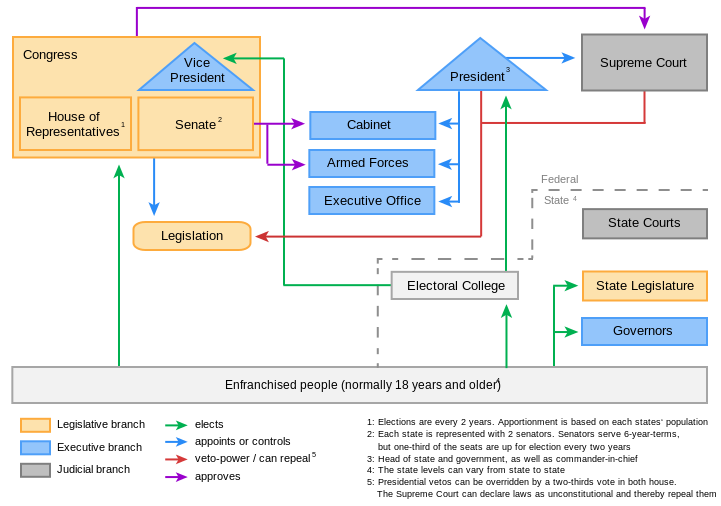
The executive is comprised of a presidency, a vice presidency (who serve a maximum of two 4-year terms), a cabinet of secretaries who head the various executive departments that implement law. The executive branch also includes independent agencies (like the Environmental Protection Agency) and independent regulatory commissions (like the Federal Reserve), both of which have regulatory power (like the power to regulate air and water quality for the EPA, or the power to regulate interest rates and the money supply for the Federal Reserve). Lastly, the executive also houses government corporations, which are government-owned entities that act much like a private corporation (they provide goods and service for a charge). Examples of government corporations are Amtrak and the United State Postal Service. Broadly speaking, executive power is the power to implement, execute, and enforce laws that are passed by a legislature and signed into law by the president. There are some other aspects of executive power beyond the implementation and execution of law: a president serves as Commander-in-Chief of the US military, they have the power to make treaties with foreign nations and appoint judges to the federal judiciary, and they can issue executive orders that direct specific government action. These executive orders are not technically law, but they can function very similarly to law. Congress has no power to overturn executive orders but the Supreme Court can and has struck down executive orders as unconstitutional.
The president and vice president are selected through indirect elections determined by the Electoral College. Each state has electoral votes that correspond to the state’s population (the greater the population, the more electoral votes) and electors cast their votes for the ticket (of president and vice president) that wins the popular vote in that state. Some states require by law that electors must cast their votes for the ticket that wins the state’s presidential election but in most states this is done by convention, not law. It is exceedingly rare for an elector to not cast their vote for the ticket that wins their state’s presidential election. There have been instances in which the ticket that wins the popular vote does not win the electoral college, notably in the recent 2016 presidential election, in which Hillary Clinton and Tim Kaine won 2.87 million more votes than the ticket of Donald Trump and Mike Pence but failed to win the Electoral College. This was the largest winning margin of the popular vote to not win the Electoral College in the nation’s history.
The federal judiciary is composed of a Supreme Court that has both appellate and original jurisdiction, and inferior federal courts established by Congress. These courts operate under the common law system, which determines precedent of past cases to be binding on judicial decisions in the present. This system is contrasted to a civil law system, in which judicial decisions are based on statutory interpretation of codified law. Eight associate justices and one chief justice are appointed by the president, confirmed by the Senate, and sit on the Supreme Court for lifetime terms. The majority of the Supreme Court’s case load is in its appellate jurisdiction, acting as the last court of appeals on major cases. In its decisions, the federal judicial courts have the power to determine the constitutionality of any state and federal law, executive orders, and other government actions. This power is not expressly stated in Article III of the Constitution. It is a power that itself was derived from the common law system of judicial decisions carrying the weight of law, in this case the majority decision of Chief Justice John Marshall in Marbury v. Madison (1803).
Reflect on the powers of government outlined in the first three articles of the US Constitution and the development of the branches of government these articles structured. Article I is lengthy and details expressed powers and limitations of the Congress. Articles II and III, on the executive and judiciary respectively, are brief and lack the detailed enumeration of powers and limitations. Indeed, one can interpret Article III to give sweeping powers to federal courts with very few limitations. Congress was unquestionably the most powerful branch of government in the early decades of the American republic, but over time, executive and judicial powers expanded. Over the 20th century and into the 21st, presidents have expanded the powers of the office at the expense of Congress, significantly broadening its war powers, issuing executive orders with regularity, using the bully pulpit to speak directly to the public and gain leverage over lawmakers, and solidifying its agenda-setting authority to establish legislative priorities. Likewise, the Supreme Court has gone from the highest court in the “weakest branch” of the federal tree to the most respected institution in federal government and the highest authority on the Constitution, with the power to make law and establish constitutional rights the moment a decision is made. The lesson here is one of theory and history: powers well defined are more easily circumscribes, whereas powers vaguely defined lack boundaries that could otherwise limit that authority and power.
Public Policy and Public Administration
Public policy analyzes and explains how government institutions respond to public concerns whereas public administration is the management, direction, and implementation of policy in order to achieve desired outcomes. One way of understanding the distinction is that public policy is the realm of ideas that solve public problems and public administration puts policies into practice. Public policy provides the ideas and public administration puts makes those ideas a reality. These two realms of policy and administration are obviously linked. Well defined policy that is attentive to the realities of how they will be implemented make the administration process more efficient. However, good policy can very often be administered poorly and poor policy can, if more rarely, be refined and improved in the administration and implementation process. The relationship between policy ideas and administration of those policies forms a substantial part of government’s day-to-day work.
Public policy is generally shaped by elected officials—politicians whose task is to formulate ideas and directions that respond to public challenges. These policy makers may be representatives in Congress, a president or vice president, state legislators, governors, mayors, and city council members, among others. Public administration is generally the purview of non-elected public officials—civil servants who are employed for the purposes of administering public services. These policy administrators may be cabinet secretaries in the federal executive branch, bureaucrats in executive implementations of law, state directors of various agencies, county or city administrators and managers, and budget directors, among others. In short, public administrators are those who work in public departments and agencies across all levels of executive government.
In the academic study of public policy and public administration a basic model has been developed that gives some definition to the policy process. There are 6 stages to this model. The first stage is agenda setting, which identifies a problem, methods for understanding or quantifying the problem, and evaluating its overall importance to the public. The second stage is policy formation, in which different approaches and solutions are weighed and evaluated, the impact of each proposal is assessed, and a “best possible” policy is forged. The third stage is policy legitimation, when policy is approved and formally adopted by Congress or a state legislature. The fourth stage is policy implementation, where the work of public administration begins, bringing formally adopted policy ideas into practice. The fifth stage is policy evaluation, in which expected outcomes (developed in the policy formation stage) are measured against actual outcomes. The policy evaluation stage also includes the process of determining how to measure outcomes and assessing the efficiency of the policy. The sixth stage includes policy maintenance, succession, or termination, in which the evaluation process gives conclusions on whether the policy should be continued, replaced with something else, or terminated altogether.[1]
States as Laboratories: Using the Comparative Method in American Politics
State governments have a general law-making authority that allows for policy experimentation useful to political scientists who study the effect and success of law. Policy approaches can be compared and contrasted with other policy approaches to determine whether intentions match outcomes. This view regards state governments as laboratories of policy making and administration—they are proving grounds that shape and cultivate policy in such a way that insights and conclusions can be drawn for other state governments or the federal government. A key example is in healthcare policy in the 21st century. The Affordable Care Act (ACA, also known as Obamacare) was largely based off of state legislation passed and implemented in Massachusetts. This state law essentially sought to achieve universal healthcare by requiring all Massachusetts residents to get health insurance (an individual mandate), while providing subsidies for lower income residents to purchase policies from private insurance companies. One of the intended effects of the law was to pool together a large number of insurance policies and thereby lower the overall cost of insurance for individuals. The Massachusetts healthcare reform was enacted in 2006 and federal policy quickly developed once Barack Obama took office in 2009. This example shows how state law can influence and shape federal policy, a bottom-up approach to policy formation.
Conversely, a top-down approach entails a process by which federal law shapes and influences state-level policy. Once the ACA went into place, one of its provisions offered state governments federal dollars to expand Medicaid so that more lower income residents could qualify. This is not a federal mandate—states could choose whether or not they would take those federal funds (which would cover 90% of the expansion) and increase Medicaid qualification. Due to the unpopularity of the ACA among conservatives, several states with Republican majorities in the legislature and/or Republican governors opted not to expand Medicaid. As of 2019, fourteen states have not adopted Medicaid expansion, although it remains a potent political issue in those states.[2] Another example of top-down policy formation is the minimum age requirement for the purchase of alcoholic beverages. In 1984, Congress passed the National Minimum Drinking Age Act, which punished states that set the minimum age to purchase alcohol lower than 21 by reducing the federal highway funds by 10%. All 50 states complied, thereby establishing a nationwide minimum age requirement for the purchase of alcohol (although state laws continue to vary on the minimum age to privately consume alcohol).

State policies also influence other state governments, and the variation between roughly similar state laws can give political scientists and policymakers insight into what makes successful policy. Take, for example, the legalization of recreational marijuana in the states of Colorado, Oregon, and Washington. There are variations on recreational marijuana policy that effects how the industry develops, how it is regulated, and how marijuana tax revenue is used. In Colorado, there is a 15% state excise tax on retail sales, a 15% tax on cultivator contracts (essentially a grower’s tax), and localities can levy their own retail and cultivator taxes. In Oregon, there is a 17% excise tax on retail sales and a capped limit (3%) on taxes localities can levy. In Washington, the retail excise tax is a whopping 37%, with no cultivator or local taxes. In 2018, despite less sales that Oregon and Colorado, Washington had the highest tax revenue from recreational marijuana, an estimated $319 million. Colorado brought in over $266 million in tax revenue from recreational marijuana, and Oregon brought in slightly less than $95 million. By law, tax revenue in Washington is directed to healthcare programs, Colorado directs its revenue to public education funding, and Oregon directs tax revenue to public education and drug prevention programs.[3]
There are a number of advantages to directing tax revenue to specific programs as opposed to putting such revenue into the general fund. Linking tax revenue to program funding creates a tighter link between policy and its intentions, providing more comprehensive direction for a policy’s effect on government and society. Directed funding from tax revenue can also decrease opposition to a policy—opponents of recreational marijuana may be concerned about potential increases in drug abuse, for example, and so policy that directs some tax revenue to drug prevention and treatment programs can mitigate against these concerns. Lastly, tax revenue directed to specific programs may reduce government costs and waste by decreasing the opportunities for lawmakers to direct funds to pet projects or “pork barrel” spending that may help with re-election but otherwise provides little benefit to the public. Analyzing variation in policy at the state level helps us reach such insights. Experiments across states ideally bring about policy that can better achieve its overall aims. Sound public policy and efficient public administration results from experience, experimentation, analysis of results, and the improvements and reforms aimed at correcting policy design flaws.
Campaigns and Elections
As previously mentioned, the electoral system in the United States is majoritarian, in which individual candidates seek a plurality of votes to win a legislative seat. A plurality means that a candidates received more votes than any other candidate (a majority of votes means that a candidate received more than 50% of the votes cast). This system is contrasted to a proportional representation system, in which citizens vote for parties that win a percentage of seats in a legislature and the parties in turn nominate representatives to fill those seats. Proportional representation systems tend to produce multiple parties that are competitive—if a party wins only 15% of the votes for an election, it roughly translates into 15% of the seats in a legislature. The US majoritarian system produces two dominant parties that remain roughly stable over a period of time, called a party system. Third, fourth, and fifth parties cannot be competitive in a majoritarian system—consistently winning 15 or 20% of the vote gives you nothing if you do not have a plurality of votes.
There is both a structural and psychological effect that produces two dominant parties in a majoritarian system. The structural effect is the very mechanics of the system, for if candidates are vying for 100% of the power that comes with a single seat, anything less than a plurality means you gain nothing, resulting in two competitive parties pitted against one another. The psychological effect describes how this majoritarian, winner-take-all system effects voters, party operatives, and candidates—voters are less likely to vote for third or fourth party options because they know there is little chance they can win, and therefore their vote will be a wasted one; party operatives are effected by this majoritarian system by recognizing their party must be a “big tent” organization that includes a large number of ideological and policy positions; and, lastly, the majoritarian system has a psychological effect on candidates themselves—potential third party candidates are simply less likely to run knowing they have little chance of winning, and candidates of the two dominant parties know they must run on a variety of policy positions and capture centrist voters key to putting them over the top.
Before general elections, parties undergo a nominating processes known as primaries. Primaries are the long and arduous process of multiple candidates vying for that party’s nomination, although in some cases primaries are something of a forgone conclusion if a candidate is uncontested for the nomination or one candidate is far more dominant than the others. During the nominating process, candidates seek to curry favor with voters, donors, and party elites by prioritizing issues, articulating policy stances, and, perhaps most important, by making the claim that they will be the strongest candidate in the general election and thus the greatest benefit to the party. There are closed and open primaries: closed primaries mean that voting is only open to citizens who are registered with that party, whereas open primaries are open to all eligible voters. Some primaries, such as those in Louisiana and Washington, have majority or two-round systems, in which the top two candidates go to a run-off or second round of voting if no candidate receives a majority of the votes cast in the first round. Lastly, there are also “top-two” primaries, in which the two candidates receiving the most votes in the primary go on to the general election, even if those candidates are from the same party. The top-two primaries are more common in districts where one party is dominant. In a very liberal district, for example, a Republican Party conservative candidate will rarely be viable in a general election, and so it makes sense to have the top two Democratic candidates face off in order to bring more competitiveness to the election.
Some studies conclude that competitive elections tend to make for more engaged voters, more issues-driven campaigns, higher voter turnouts, and politicians who are held to greater accountability.[4] Competitive elections may also be a good indicator for the health of a democracy—if elections are consistently uncompetitive and incumbents are rarely challenged, this may be a sign of disengaged or marginalized voters and may result in stagnant governance. Incumbents in elections are candidates who are currently holding the office and running for re-election. Incumbency advantage in elections is strong—incumbents typically have more money and are known quantities familiar to voters and donors. Politicians spend considerable time and energy on campaigns to win elections. In a classic book on American politics, David Mayhew’s Congress: The Electoral Connection makes a compelling argument that much of the organization and outcomes of Congress can be explained by election-seeking behavior of representatives. In short, decisions made by congresspersons are almost entirely tethered to their re-election prospects. Legislation they support, committees memberships they seek, and public addresses they make are all tied to what voters back home will think of those actions.
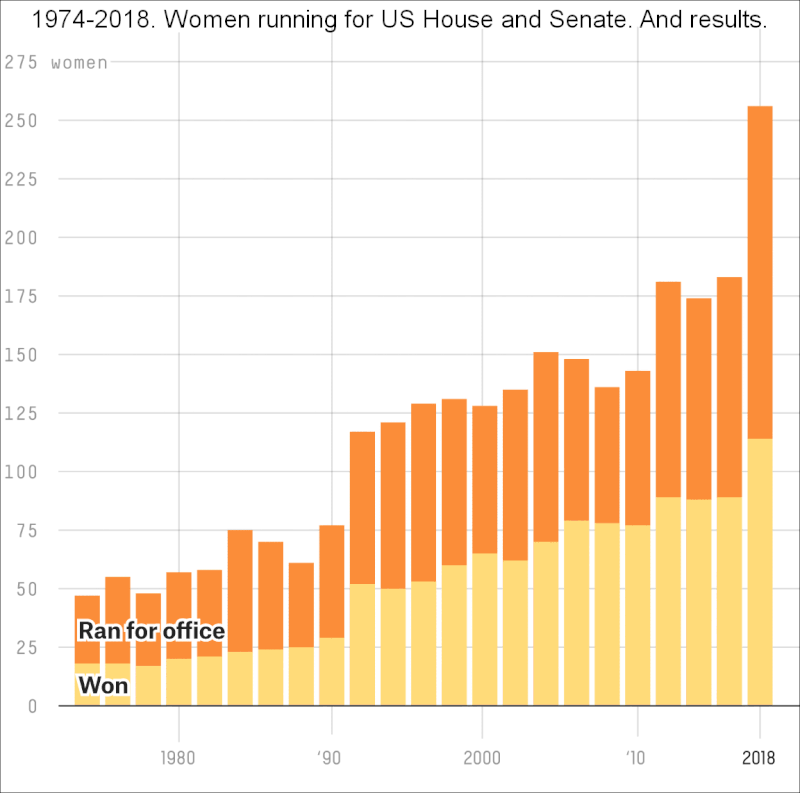 Although issues matter, election coverage by news media is generally dominated by the personalities of the candidates (their background, style, and performance) and the state of the “horse race” (who is ahead, who is behind, and who is gaining or losing ground in the race). This lends a spectatorial and performance driven nature to the American electoral environment. Successful candidates capture attention and coverage by performing well in a public setting. Politicians who are smooth, articulate performers tend to have an advantage over politicians that are knowledgeable, issues-driven policy wonks with a little less flair in the limelight. This suggests a dynamic between electoral politics and governing politics that tends to favor election spectacles over the messy and procedural process of governing, at least in terms of public attention. Elections can be splashy and entertaining, adjectives rarely applied to the governing process. The public tends to pay more attention to politics during election season and ratings for news media tend to be higher. As we shall see, all of these dynamics tend to be heightened in presidential elections.
Although issues matter, election coverage by news media is generally dominated by the personalities of the candidates (their background, style, and performance) and the state of the “horse race” (who is ahead, who is behind, and who is gaining or losing ground in the race). This lends a spectatorial and performance driven nature to the American electoral environment. Successful candidates capture attention and coverage by performing well in a public setting. Politicians who are smooth, articulate performers tend to have an advantage over politicians that are knowledgeable, issues-driven policy wonks with a little less flair in the limelight. This suggests a dynamic between electoral politics and governing politics that tends to favor election spectacles over the messy and procedural process of governing, at least in terms of public attention. Elections can be splashy and entertaining, adjectives rarely applied to the governing process. The public tends to pay more attention to politics during election season and ratings for news media tend to be higher. As we shall see, all of these dynamics tend to be heightened in presidential elections.
Running for president of the United States is arguably the biggest show in all of politics. Presidential candidates run long, expensive campaigns that typically start over a year before the general election. It begins with candidacy announcements in which individuals publicly declare they are running for president. These announcements are themselves political shows intended to maximize coverage and energize supporters. Declared candidates then go through with the nominating process in which state primaries or caucuses are held for both the Democratic and Republican Parties. Primaries are preliminary elections, either open or closed, in which Americans vote directly for candidates that seek the party’s nomination. The winner of a state primary captures that state’s nomination for the party. Caucuses are meetings held in town halls, schools, and other public venues in which supporters discuss and vote for candidates seeking the party nomination. Voting is more informal in caucuses—rather than go to the polls and cast ballots, attendees gather and vote in smaller settings. The two major parties assign each state a number of delegates. Delegates will then pledge their votes to the candidate who wins that state’s primary or caucuses.
The Iowa caucuses are the first major event in the nomination process and gives the small Midwestern state an outsized role in the selection of president—Iowa is seen as a barometer for future success of candidates in the nominating process. A win in Iowa or a better showing than what was expected can provide a big boost for a campaign. Conversely, a poor showing in Iowa can significantly derail a campaign. The New Hampshire primaries are the second stop in the nominating process and after votes are counted in that state the public typically has a clearer idea of who the frontrunners are for the party’s nomination. After the Nevada caucuses and South Carolina primaries, several states hold simultaneous primaries and caucasus in what is known as Super Tuesday, generally a day in late February and early March of the presidential election year. With candidates crisscrossing the country, money pouring in and out of their campaign organizations, the race for the party nomination begins to take shape through the spring. The winning candidate will usually wrap up the nomination by early summer, well before the party convention in which the candidate is formally nominated. The US presidential nominating convention will select the party nominee for the general election, but will also adopt a statement of party principles referred to as a platform and establish rules and procedures for the next presidential election cycle. Historically, conventions were often brokered—multiple candidates continued to vie for the nomination and there was varying degrees of doubt as to who would actually win. In a brokered convention, the event itself will settle the matter. Brokered conventions are now rare in American politics, the last was in the 1976 Republican convention, in which a post-Watergate party in disarray ultimately settled on the sitting president, Gerald Ford.
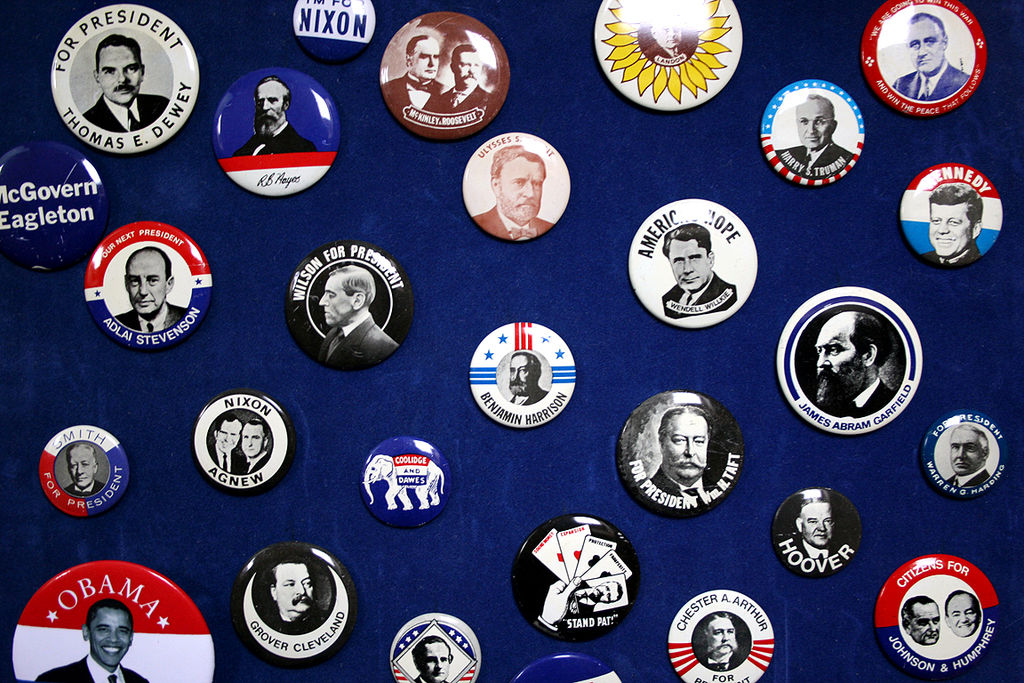
Lastly, the Electoral College is the system designed to select the president in a general election. Each state runs their own election system—some states use paper ballots, others use electronic voting machines, and every state has a different system for registration, process for absentee voting, among other procedures. Oregon is unique in that the state implemented a statewide mail-in balloting system for their elections. There are no polling places. Ballots are mailed to registered voters, who can make their selections at home and place the sealed ballot in a registered drop box site before election day. The process is convenient, cost efficient, and helps produce one of the highest voter turnout rates in the country. The Electoral College is composed of 538 electors divided among states based on population. State elections determine who the electors of that state will vote for. Almost all states will allot all of their electoral votes to the winning candidate of that state’s election, regardless of how small the margin of victory. The exceptions are Maine and Nebraska, who divide up their electoral votes among the districts of those states. The winning candidate of each district wins that district’s electoral votes. The candidate that wins the presidential election must win a majority of the electoral college votes: 270 is the minimum number required.
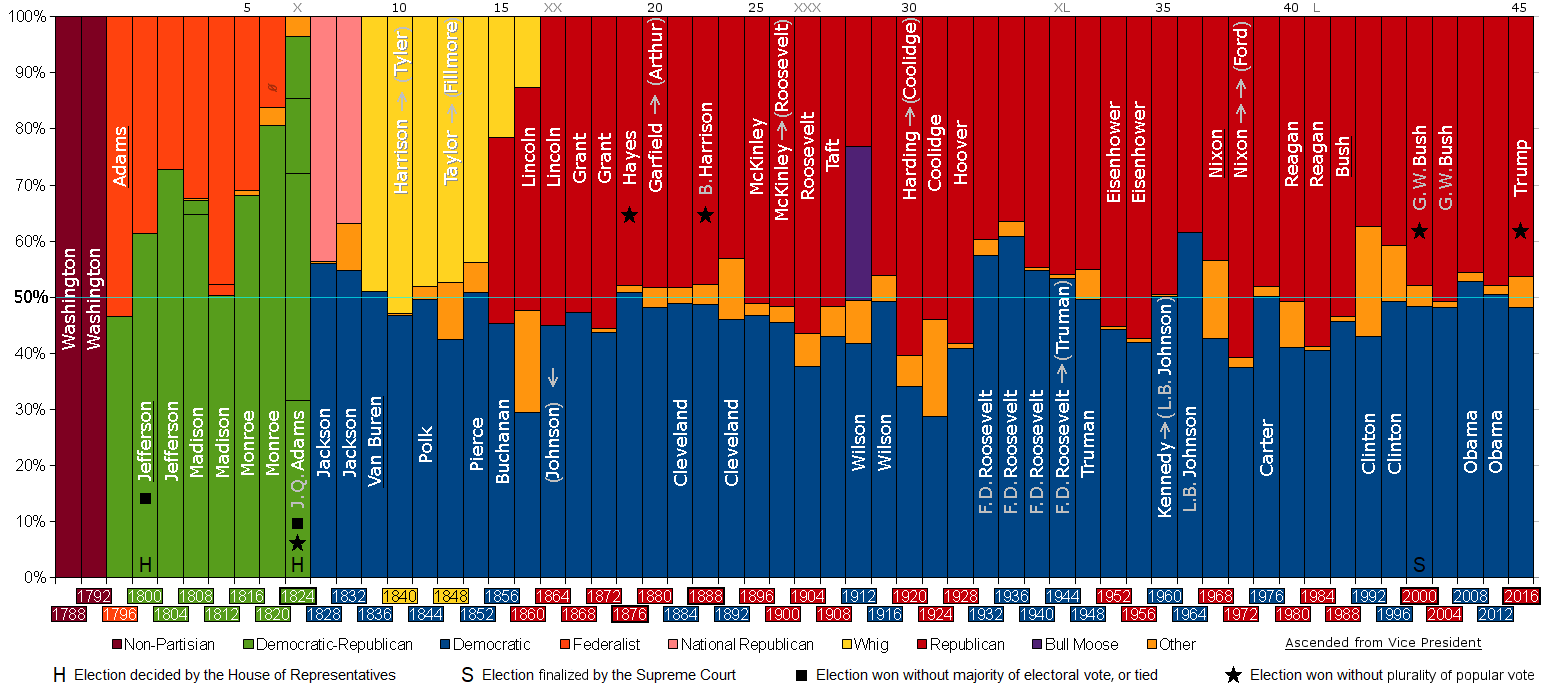
Mediating Institutions: Political Parties
In understanding the dynamic of American politics and how it operates through American government, it is important to analyze mediating institutions. A mediating institution is one that filters and shapes politics and influences government institutions and actions. The role of political parties has a profound effect on American politics. Political parties may be an organic outgrowth of any democratic society. A political party is an organization built around shared policy and ideological platforms and serves as an organizational structure that selects and supports representatives in government. There is no mention of political parties in the US Constitution, but parties almost immediately emerge in American political history, quickly becoming fundamental to the process of interest-based governing. James Madison’s Federalist 10 discusses the dangers of factions—organized groups that seek to direct government toward their interests. The danger here is that government will be more responsive to particular groups, or special interests, and not the common good. For Madison, factions cannot be destroyed, because to do so would destroy democracy itself. The answer, according to Madison, is to manage factions by designing a divided government of checks and balances that make it hard for one special interest or faction from monopolizing government power. We may view political parties as factions in this sense, seeking to influence government and direct its actions to the benefits of the party and its supporters. Parties, however, have a number of benefits in a democracy—they mobilize voters, establish a platform in which ideas and policies can be expressed and scrutinized, and cultivate representatives that make good public servants.
As previously mentioned, party systems are historical eras of stability between two major parties. There at least 5 party systems in American history. The first party system emerged as a split among the Federalists, who saw themselves as defenders of the Constitution and advocated for an active government, and the Jeffersonian Democrat-Republicans, who were wary of centralized authority and the tyranny of government that could undermine the liberties of the people. The Democrat-Republicans took up the anti-Federalist banner. Federalists advocated for a strong national bank, close ties with England, an active federal government, and economic policies favored to wealthy financial and commercial interests. Alexander Hamilton, the first Treasury Secretary of the United States and perhaps the most powerful political figure in American history who did not serve in Congress or as president, is a prime example of high federalism. Hamilton, one of the main architects of the Constitution, was one of the first individuals to interpret the Necessary and Proper Clause of Article I, Section 8, and argued for a broad, far-reaching interpretation that could empower Congress to realize the massive potential of the nation’s economic and military power. Thomas Jefferson, the philosopher-statesman who would become the 3rd president, led the Democrat-Republicans, who abhorred the notion of an expansive and active government the Federalists endorsed. For Jefferson, a limited government made for a freer society.
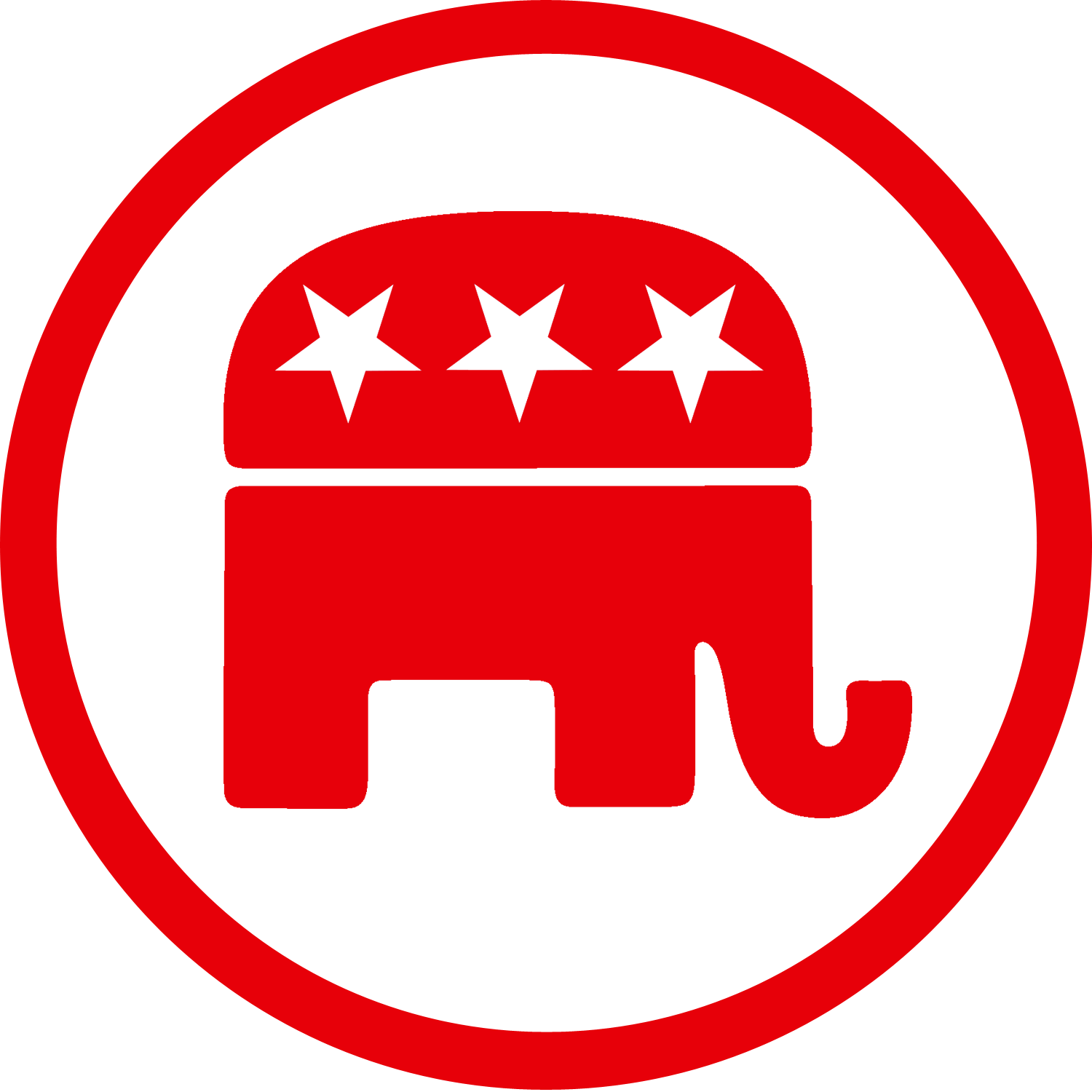
The elitism of the Federalists diminished their appeal, particularly after the War of 1812. With the balance of power shifted to the Democrat-Republicans, internal divisions within the powerful party began to emerge. These are periods in party history scholars refer to as realignments, when stable party systems breakdown. In such realignments new parties may emerge to replace one of the two dominant parties, or party names stay the same while new ideas transform the party platform, usually corresponding to a demographic change in the party supporters. The second party system that emerged included all of these changes. The Democratic Party, who carried the mantle of Jefferson, was against a federal bank, internal improvements, and paper money. Led by Andrew Jackson, the Democrats also advocated for universal white male suffrage—the end of property qualifications for voting. The Whig Party tended to be more urban, elite, and northern, and were for a federal bank, internal improvements, and paper money. The second realignment, which takes place in the years leading up to the Civil War, was sparked by the fracture of the Whigs over the issue of slavery. The Whig Party was dissolved and former Whigs of the north were reconstituted as the Republican Party, with a platform committed to equality and the gradual end of slavery. This third party system is forged in the Civil War and lasts through the end of the 19th century, when a major realignment drastically changes the ideas and platforms among the two parties, although the names remain the same.
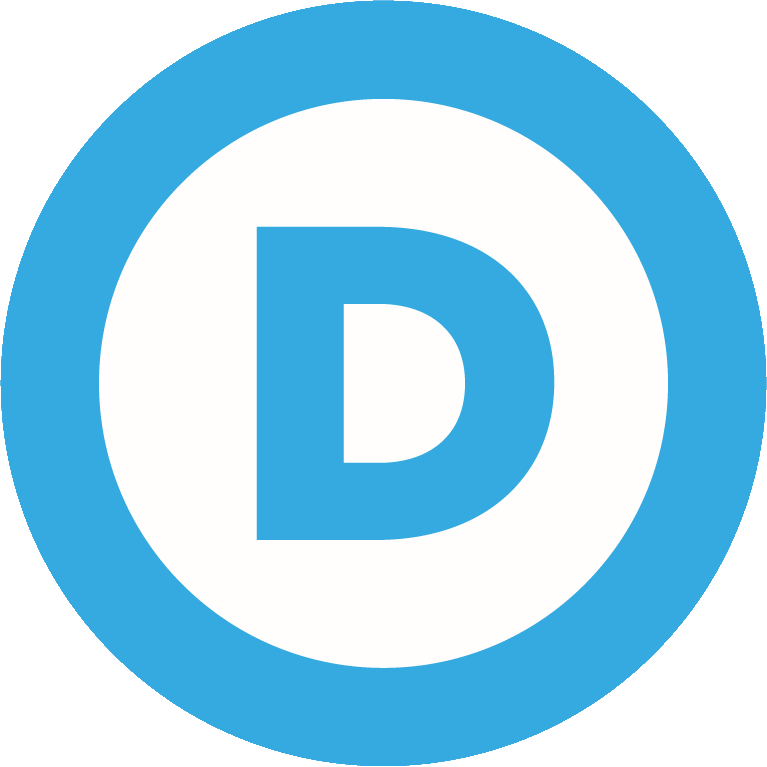
Politics at the turn of the 20th century sought to respond to social transformations brought about by industrialization, immigration, and urbanization. Issues such as child labor, big business and monopoly, economic regulation, women’s suffrage, direct election of senators, and Prohibition dominated the Progressive Era. Both parties had progressive factions within them that wanted to aggressively respond to these problems and revitalize government to deal with them. The fifth party system emerges at the end of the 1920s, when the Great Depression weakens the Republican Party, who had gradually abandoned progressivism and sought to shape a social conservative and pro-business platform. The Democratic Party reshapes itself as a modern liberal coalition of southern “Dixiecrats” who supported social programs that tackled poverty and provided economic benefits to working class Americans and northerners who supported these social policies but also attentive to racial inequality in America. Whether this fifth party system remains is the subject of much scholarly debate, but there was clearly a significant realignment in the 1960s, when Lyndon B. Johnson’s support of civil rights alienates much of the Democrats of the south, who moved into the Republican Party in large numbers. Today, the Republican Party remains strong in the south and the American heartland, whereas the modern liberal Democratic Party is dominant on the American coasts.
Mediating Institutions: Media
A key mediating institution in American politics is media—both traditional news media and the broader, and rapidly changing, media landscape. Traditional news media in America is privately owned and almost entirely unregulated. In consolidated corporate capitalism, most traditional news outlets are owned by larger multinational corporations. Although news media are guided by profit motivation, there are three main civic responsibilities of news media in a democracy. First, news media are expected to provide a forum in which candidates contest for public office by broadcasting debates, providing information on campaign rallies and speeches, and giving candidates access to the public. Second, news media provides for an informed public by covering the events of the nation and world. In this respect, an informed public is essential to the health of a democracy—in a government by and for the people, it is necessary that the people have balanced and objective information on events that effect the public. Third, news media are expected to be a watchdog on the state, scrutinizing government and its actions and reporting on political corruption or abuses of power.
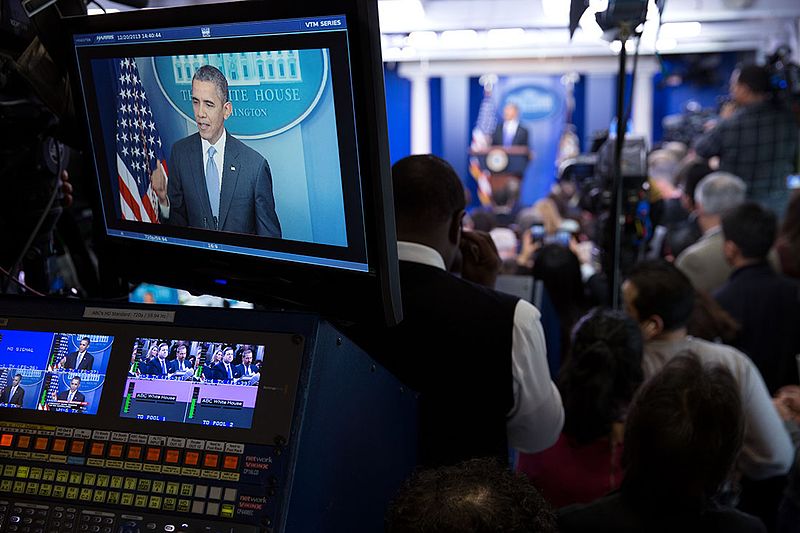
Is there an inherent tension between the profit motivation of privately-owned news media and these civic responsibilities? To what extent have these responsibilities eroded in our 21st century democracy? These are important political questions that are central to the public’s relationship to government. The news media landscape has undergone tremendous change over the past 20 years as traditional news outlets, particularly newspapers, have declined and internet-based media has exploded in growth. Prior to the development of the internet, traditional news media essentially controlled the marketplace of disseminating news events and were staffed by professional journalists who operated under the values of autonomy and objectivity. We now have a much more flattened news media environment, with a variety of alternative sources available, citizen journalists, and significant blurring between objective news, opinion, and soft news. The advent of social media has exacerbated these changes, allowing users to share anything they deem newsworthy. Such a flattened and open environment has made it possible for bad-faith actors to propagate disinformation and fake news in an effort to sow distrust or shape the public’s perception.
Objectivity is an important journalistic concept that can easily be misunderstood in partisan politics—news that calls into question the efficacy of certain policies and ideas or that might embarrass or discredit a particular politician may be deemed biased by supporters, even if the reporting is accurate. Objectivity does not imply that reporting is purely, 100% unbiased—it is perhaps inevitable that even the most objective reporting will bring with it some bias of the journalist’s worldview. Our perspectives and worldviews shape how we understand the world and how we describe it. It is, however, crucial that journalists strive for objectivity in gathering, assessing, and presenting information on important events. Journalists are trained to tell other people’s stories, not their own, and to balance reporting by “indexing the news,” a process by which journalists seek alternative viewpoints to those being expressed. In other words, sources who share opinions should be balanced by other sources with altering opinions. The job of a journalist is to gather these viewpoints and present them fairly.
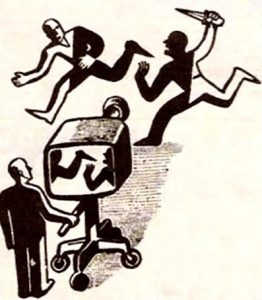
Lastly, let’s consider some key journalistic strategies for presenting news information. First, news media follows the process of agenda setting—deciding which issues will be presented and in what order. Because news media cannot report on all the events that happen in the nation, let alone the world, a degree of agenda setting is necessary. For the public, it is important to be aware of which issues are covered, in what order or with what degree of emphasis, and which issues are not covered. Second, news media engages in the process of framing information—deciding what aspects of an event or issue they should cover, thereby providing a frame that emphasizes certain facets of the issue and de-emphasizing other facets. There are two very different framing strategies—episodic framing and thematic framing. Episodic framing tends to cover events in isolation, like stand-alone episodes with little context or connection to other events. Causes of events are typically individual in episodic framing—some individual perpetrated some isolated act. Thematic framing, on the other hand, tends to look at the context that surrounds events and tries to explain its connection to other events. Causes are not individual but societal, institutional, or structural. Take the issue of mass shootings in America, which have become alarmingly common in our everyday life. Episodic framing with report on isolated mass shooting events and focus on the shooter as the sole cause. Thematic framing will emphasize the context and draw connections to other mass shootings in seeking to find a broader social or cultural cause as to why these shootings continue to occur.
Conclusion
In this chapter we provided an overview of American political institutions, particularly the federal government’s constitutionally designed branches of legislative, executive, and judicial power. Public policy and administration is briefly discussed, and a distinction is made between public policy—the realm of ideas that seek to solve public problems—and public administration, the practical implementation and realization of those ideas. Further, a 6-stage process of public policy and administration is important to understand how policy is developed, implemented, and evaluated. In short this process is 1) agenda setting, 2) policy formation, 3) policy legitimation, 4) policy implementation, 5) policy evaluation, and 6) policy reform, continuation, or termination. Next, this chapter seeks to understand states in American politics and laboratories for policy. When states design and implement similar policies, political scientists and policymakers can compare, contrast, and analyze their effects, assessing the degree to which policy successfully identifies and responds to public problems.
We then looked at campaigns and elections, an important dimension of American politics that is often more visible to the public than the day-today practice of governing. The American democratic system has both direct and indirect representation within a federalist system, which requires 50 state governments and a federal government to coordinate and interact in order to govern for the benefit of the public. Lastly, we looked at two mediating institutions that have a profound effect on American politics—political parties and media. Party organizations govern the process of selecting, financing, and supporting candidates for public office. New media is privately owned and largely unregulated, but in a democracy, the expectation is that profit-motive should rest alongside and not undermine civic responsibilities news media have to the public, namely to provide an electoral forum, inform the public, and be a watchdog on government and its actions.
In our next chapter, we will return to the basic tools of social science inquiry and look at the sub-field of methods in political science.
Media Attributions
- 721px-Political_System_of_the_United_States.svg © 111Alleskönner is licensed under a CC BY-SA (Attribution ShareAlike) license
- 1024px-Smelling_the_marijuana_in_Verde_Natural_Cannabis_Dispensary © My 420 Tours is licensed under a CC BY-SA (Attribution ShareAlike) license
- 800px-1974-2018._Women_running_for_US_House_and_Senate._And_results © fivethirtyeight.com is licensed under a Public Domain license
- 1024px-US_presidential_election_badges © Andy Clarke is licensed under a CC BY-SA (Attribution ShareAlike) license
- PartyVotes-Presidents © ChrisnHouston is licensed under a Public Domain license
- Republican_Disc © Republican Party
- Democratic_Party_Logo © Sfs90
- Barack_Obama_year-end_press_conference,_2013 © Lawrence Jackson is licensed under a Public Domain license
- tumblr_p383u7FGu91w49lylo1_400
- William Fox, Sayeed Bayat, and Naas Ferreira, eds. A Guide to Managing Public Policy. Juta & Co.: 2006; James E. Anderson, Public Policymaking, 7th ed. Cengage Learning: 2011. ↵
- Kaiser Family Foundation, "Expansion of Medicaid by State," May 13, 2019: https://www.kff.org/medicaid/issue-brief/status-of-state-medicaid-expansion-decisions-interactive-map/ (accessed on July 24, 2019). ↵
- Tax Policy Center, "How Do Marijuana Taxes Work?" 2018: https://www.taxpolicycenter.org/briefing-book/how-do-marijuana-taxes-work (accessed on July 24, 2019); Niall McCarthy, "Which States Made the Most Tax Revenue from Marijuana in 2018?" Forbes, March 26, 2019: https://www.forbes.com/sites/niallmccarthy/2019/03/26/which-states-made-the-most-tax-revenue-from-marijuana-in-2018-infographic/#66e126c67085 (accessed on July 24, 2019). ↵
- Keena Lipsitz, Competitive Elections and the American Voter. University of Pennsylvania Press: 2019. ↵

